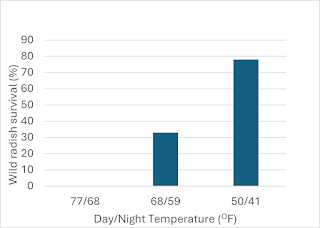
from Minnesota shows the presence of glyphosate
-resistant populations. The color gradient from green
to red indicates the reduction in glyphosate sensitivity
among the populations tested. The counties in white
were not surveyed.
Navjot Singh – Weed Science Graduate Student, UMN,
Debalin Sarangi – Extension Weed Scientist, UMN
Liz Stahl – Regional Extension Educator – Crops, UMN
Joe Ikley – Extension Weed Scientist, NDSU
Tom Peters – Sugarbeet Extension Agronomist, NDSU/UMN
Glufosinate is a non-selective, contact herbicide (site-of-action Group 10) used in glufosinate-resistant corn, soybean, and canola. Herbicides like Liberty 280 SL, Cheetah, Finale, Interline, and Sinate contain glufosinate, with Liberty 280 SL being the most commonly used product among them. In addition to burndown applications before planting, glufosinate is mostly used for over-the-top applications in LibertyLink crops. However, label restrictions for rate and crop stage should be followed. The herbicide-resistant trait choices available for row crops in Minnesota and North Dakota are summarized in this article.
 |
| Figure 1. A recent waterhemp population survey from Minnesota shows the presence of glyphosate -resistant populations. The color gradient from green to red indicates the reduction in glyphosate sensitivity among the populations tested. The counties in white were not surveyed. |
Glyphosate resistance in waterhemp has been documented to be widespread in Minnesota (Figure 1). As a result, farmers have been relying more frequently on glufosinate for effective management of this weed. Surveys conducted at Private Pesticide Applicator Recertification Workshops by UMN Extension indicated that control with glufosinate has been less than optimal for some farmers in Minnesota.
Resistance to glufosinate has not been confirmed to date in any weed populations in Minnesota and North Dakota. However, conditions at application and/or application practices are likely playing a role where control has been less than optimal. The following are several considerations for achieving optimal weed control with glufosinate, using the Liberty 280 SL label as a reference (always refer to the herbicide label for the specific product you are using).
 |
| Figure 2. Waterhemp survived a 32 fl oz/A rate of Liberty application as the herbicide was applied when weed height was more than 4 inches. Regrowth is occurring from the lower growing points at 21 days after application. (Photo: Debalin Sarangi) |
Weed height: Liberty is a postemergence herbicide, so only weeds that have emerged will be controlled. Weed height is critical when using glufosinate. The herbicide should be applied to small, preferably less than 3 inches tall actively growing weeds. If applications are made to taller plants, one can expect regrowth from the lower growing points (Figure 2). This time-lapse video shows the influence of waterhemp height on the efficacy of Liberty. The shoot regrowth is visible when the herbicide was applied to 6-inch and 1.5 feet tall waterhemp plants.
 |
| Figure 3. Wild radish survival after glufosinate application impacted by the air temperature. (Source: Kumaratilake et al. 2005). |
Temperature: The Liberty label states that warm temperature, high humidity, and bright sunlight improves the performance of this herbicide. Figure 3 shows the impact of temperature on the efficacy of glufosinate on wild radish. Survival was 78% at 50/41 °F day/night temperatures, whereas no plants survived at 77/68 °F day/night temperatures. For reference, air temperatures for May and June at Rosemount, MN are plotted in Figure 4. This shows that farmers can expect better performance if glufosinate is sprayed in later May or June versus earlier in the season.
 |
| Figure 4. Daily and 30-year average temperatures at Rosemount, MN, for May and June when Liberty application is expected. |
| Figure 5. Higher Palmer amaranth, redroot pigweed, and waterhemp control when Liberty applied at 90% relative humidity vs. 35%. (Source: Coetzer et al. 2001). |
 |
| Figure 6. Higher Palmer amaranth injury resulted from Liberty application at midday (left picture) compared to dusk applications (right picture). Plants in the left row in each picture were the nontreated controls. (Source: Takano HK and Dayan FE 2021). |
Kumaratilake AR and Preston C (2005) Low temperature reduces glufosinate activity and translocation in wild radish (Raphanus raphanistrum). Weed Science 53:10-16
Coetzer E, Al-Khatib K, Loughin TM (2001) Glufosinate efficacy, absorption, and translocation in amaranth as affected by relative humidity and temperature. Weed Science 49:8-13
Takano HK and Dayan FE (2021) Biochemical basis for the time-of-day effect on glufosinate efficacy against Amaranthus palmeri. Plants 10:2021
Products are mentioned for illustrative purposes only. Their inclusion does not mean endorsement and their absence does not imply disapproval.